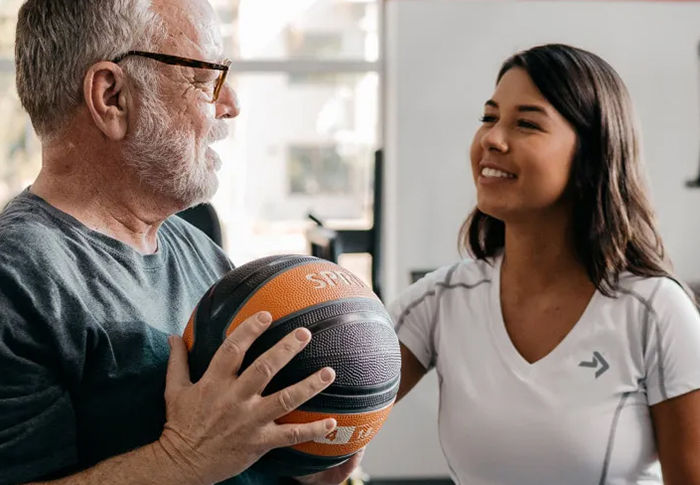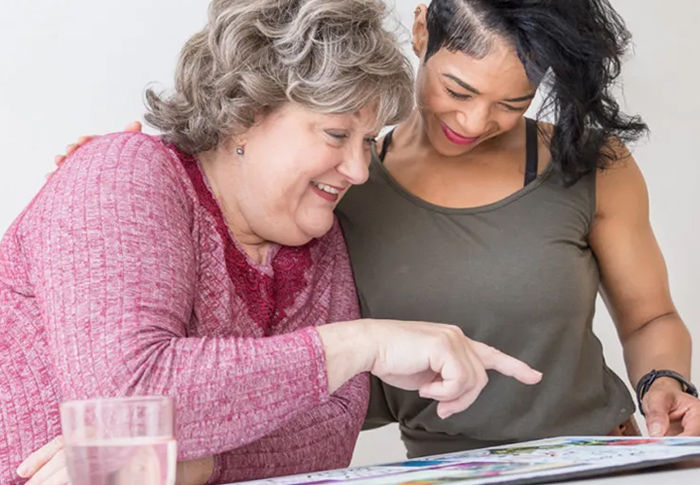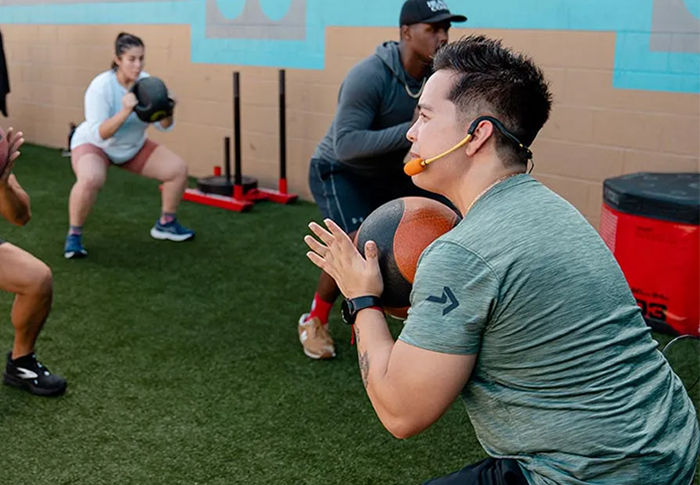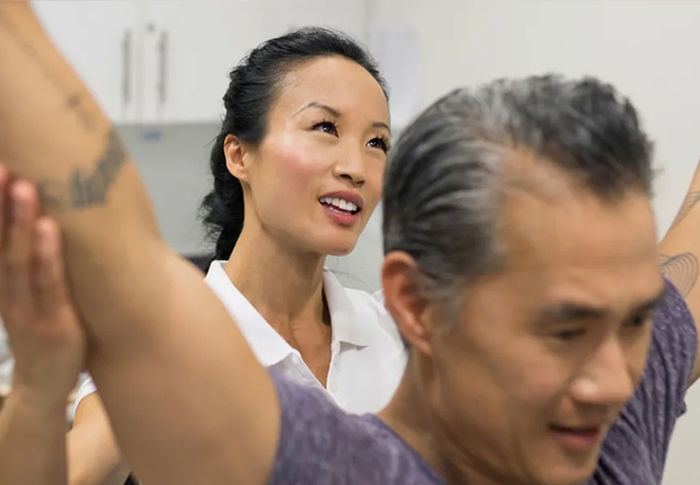
Bob Phillips was taken aback by the text from his long-time client Joanie.
Phillips, who lives in Athens, Tenn., had trained Joanie and her husband Mark for about 20 years. They used to do two or three sessions a week at their home gym on Long Island, N.Y. When Phillips moved south, they switched to Zoom.
But the delivery mode of Phillips’s training wasn’t the only thing that changed. Phillips knew that Mark and Joanie had been having marital issues. “You pick up on little things,” he recalls. “I got the sense there was tension.”
He thought he had navigated the situation as well as he could. He was continuing to train both of them, separately. But Joanie’s text was going to change that arrangement. It read: Can I ask you not to reach out to Mark? He has destroyed my health, and I am trying my best to help myself. He knows that I told you. And when you are friendly to him, he thinks you approve of what he has done to me.
Phillips had worked with Joanie before he’d met with Mark (and we should note their names have been changed for the purposes of this story). But that was so many years earlier—he would have been happy to keep two good clients, both of whom he enjoyed working with. Reluctantly, he assented to Joanie’s request.
Phillips’s experience illustrates a dilemma that many health and exercise professionals may face over the course of their careers: Couples—husband/wife, boyfriend/girlfriend, siblings or any partnership of two individuals—can be a lucrative addition to one’s client roster. “It’s a great source of business,” says Phillips. “It’s also a good selling point with other clients.”
But it’s also fraught with potential minefields. What do you do when a rift develops between the couple you are training? “You’re really caught in the middle,” says Phillips, who has trained many couples over the years—most of them, it should be added, with no disruptions.
Still, although divorce rates have declined in recent years, an estimated 40 to 60% of marriages end in divorce. That means it’s almost inevitable that some of the couples happily doing lunges together one year, might be calling their lawyers the next. When that happens, Phillips says, “you sometimes almost have to choose between one or the other.”
The challenge of training couples isn’t limited to people who are married or romantically involved. Reginald Fox, a trainer with PureGym (formerly Blink Fitness) in New York City, recalls a client—a young woman—who one day asked if her “bestie” could join them in the gym. Fox was open to the idea. He, too, recognizes the value of having couples on his client roster. “In the same amount of time you’d train one person, you can bill for two people,” he says. “It’s a good time-management thing.”
Unless, that is, you have to spend more time refereeing problems than you do training. It soon became apparent that only one of the two supposed best friends really wanted to do the work in the gym necessary to see results. “Client 1…my original client…started showing up late, she wasn’t eating well, she wasn’t sleeping well, and it showed in the workouts,” Fox said. “Client 2 was always ready to go.”
As a result, Fox was constantly having to adjust the workouts to accommodate Client 1 “because she didn’t have any energy,” he recalls. “The two friends just weren’t on the same page when it came to taking their overall training seriously.”
Client 2 is still a client—solo—and, according to Fox, is making “impressive” gains in the gym. As for her friendship with Client 1…well, he doesn’t ask. Apparently, there were also disagreements about who was paying for which sessions between the friends.
The experience taught him a lesson. “When it comes to two people working together, I realize that I have to come up with an agreement about attendance and payment arrangements from the start,” he said.
Leigh Anne Bolling Richards agrees that communicating early and often is a key when working with couples. In the case of training two friends, she said, “if there seemed to be a problem between them that was affecting their training, I would want to sit down with them, and say, ‘Hey, I know you guys are good friends, let’s talk it through,’” says Richards, a former club manager and trainer, who now leads RockSteady Boxing classes at the YMCA in Montgomery, Ala. “You’re here to get your workout. Let’s figure out how to do that.’”
If you’re a personal trainer, a powerful inducement to work with couples is the fact that they make good business sense. “You’re basically planning for one workout, but you’re getting paid by two clients,” says Bolling Richards. But be aware of any tensions that might cause impediments in their training. “If it starts to become a competition for them or it starts to get snarky, then you may need to sit down with both clients and say, `Y’all, maybe we should start having separate sessions.’”
Veteran trainer Matt Sulam has trained many couples in his 30-year career, both in-home and online. His recommendation: Don’t let either client take charge of the workout. “Be aware of one spouse funneling their issues through you, as to what they’d like their partner to work on,” advises Sulam. “That could be anything from, ‘He needs to work on his posture,’ to ‘Can you do something to tone her arms?’”
Obviously, clients can and should ask questions, but it is important that individuals stay focused on their own goals and health and wellness journey without attempting to set goals for each other.
Finally, keep in mind that relationships change. Sometimes for the worse, as when Bob Phillips got that text from his client Joanie asking him to cut off communication with her husband. And sometimes for the better—as was the case with another text Phillips got from Joanie, a few months later.
“She wrote me and said, ‘Mark wants us to train again.’” Surprise! “It went from where I was just training her and then I was training no one, and now I’m back training them both again.”
Did Mark leave and come back? Have they reconciled as a couple?
That’s none of our business.
“It’s kind of like a ‘don’t ask, don’t tell,’ thing” says Phillips. “And I’m not their therapist. It’s like, ‘O.K., so you guys want to train together with me again? Good, let’s get going.’”
Practicing the Art of Personal Trainer Diplomacy
The nation of Switzerland has been officially neutral since the Congress of Vienna in 1815. The key to success in training couples—without getting sucked into drama between them—is to be like Switzerland.
“When a couple splits up, acquaintances often feel like they have to take sides,” says Sherry Pagoto, PhD, a licensed clinical psychologist and professor at the University of Connecticut. “But if you’re neutral from the beginning, you’re probably less likely to get sucked into the conflict.”
A good way to plant your flag of neutrality, she says, is to “approach the couple as a unit from the beginning.” That way, she says, if there are disagreements, you’re less likely to get drawn into them.
You may also need to avoid empathetic listening, which is a foundational principle of health coaching, but may not be appropriate when training couples. Empathetic listening involves reflecting back the emotions you hear (For example, “you sound angry and upset.”) and is used to build trust between clients and coaches and trainers. However, explains Dr. Pagoto, “The danger of empathetic listening with clients is that it can be construed as validation and that can be used as ammunition against the other partner.”
Instead, she recommends changing the conversation—switching it back to training, if possible. Or if it seems that the partner confiding in you seems deeply upset, you could suggest that “it might be good to talk to a therapist about this.”
Despite the delicate dance it sometimes entails, Dr. Pagoto still thinks health and exercise professionals should welcome couples as clients to their business. And not just because it’s more time efficient. “There’s so much research to show that when you exercise with a friend or spouse, you’ll have better adherence,” she says.
Not to mention a better attitude toward training in general—and toward one’s spouse. A 2021 study published in the Journal of Social and Personal Relationships showed that on days when people exercised with their romantic partner, they experienced higher positive affect and were more satisfied with their relationship compared to days when they exercised without their partner.
In sum, couples training together can lead to better results—and that means happier clients.





 by
by 


